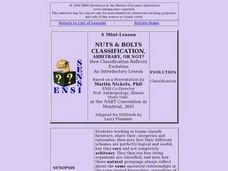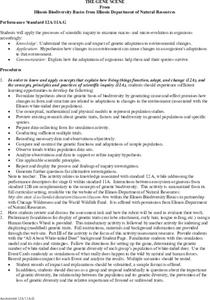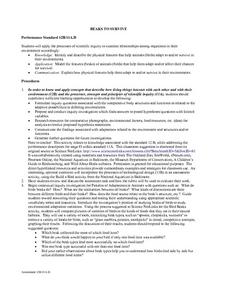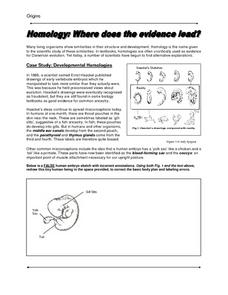Curated OER
What's That? Diversity Among Organisms
Seventh graders can go outside and explore the organisms that live in the environment outside their door. This is a wonderful opportunity for students to examine the world around them with a new perspective. This activity will increase...
Curated OER
Crab Lab
Learners participate in an activity in which they observe the behavior of a crab. In groups, they label and identify the function of each main part while observing and record their behavior. They make educated guesses on why they...
Curated OER
A TOUGH NUT TO CRACK
Based on a set of criteria, students will evaluate the quality of pecans.1. Bring a gram scale and papershell pecans. Provide five pecans for each student. 2. Divide the class into groups of five and provide each member with five pecans....
Curated OER
Penguin Parents are Cool
Fourth graders explore the lives of penguins and the relationship between them and their parents. They compare and contrast penguin populations in various areas of the world as well as their nesting sites. After constructing a penguin...
Curated OER
Land Biomes Research and Presentation
Fifth graders work in cooperative groups to research an assigned land biome using various sources. Groups create either a book or a PowerPoint presentation of their assigned land biome.
Curated OER
Nuts & Bolts: is Classification, Arbitrary, Or Not?
Students, in groups, classify furniture, share their categories and rationales, then note how their different schemes vary, perfectly logical and useful, but completely arbitrary.
Curated OER
ISM: Bertha Stenge Quilt Collection Activity: Design a Local Quilting Pattern
Students research quilt designs by Bertha Stenge. They make a list of things that they could stylize as a design motif. They create a quilt design based on local history and landmarks and sew it onto a pre-made quilt block or quilt.
Curated OER
Show Some Backbone and Teach Invertebrates
Fifth graders identify two similarities and two differences between two phyla, assign fictitious invertebrate to its phylum and explain why it belongs in that grouping, and construct member of given phylum and explain why it should be...
Curated OER
Where Should We Place Archaeopteryx?
Students classify Archaeopteryx using pictures of actual fossils and scientist representations of how the animal might have looked. They compare Archaeopteryx's characteristics to those of the five extant vertebrate groups to...
Curated OER
Fossils-Where Should We Place Archaeopteryx?
Students explore an interactive computer activity that provides the opportunity to look at features of various groups of animals and determine where an extinct organism might be classified.
Curated OER
Our Environment
Students engage in a literature study that helps students to connect with some of the issues of conservation. They list parts of the environment that need protection with the help of a graphic organizer. Then students discuss in groups...
Curated OER
Seeing Cells
Sixth graders study living cells and their functioning units. In this cell lesson students color cell diagrams, answer questions and discuss the differences between plant and animal cells.
Curated OER
The Gene Scene
High schoolers investigate the concepts of micro and macro evolution. They also research the effects of mutations in the process of genetic adaptation to different environments. They develop a hypothesis of how the environment can...
Curated OER
Seeds and Similarities
Young scholars use the scientific inquiry method to identify the changes in a plant's life cycle. In groups, they plant different types of plants and use a chart to compare and contrast their growth rates. They share their conclusions...
Curated OER
Beaks To Survive
Students discuss and identify the types of adaptations that are made by different organisms in order for them to survive. In groups, they describe the features of beaks and discuss how it affects their chances for survival. They share...
Curated OER
Who Turned the Lights Out?
Students discover the life cycle of butterfly by observing its growth from egg to caterpillar and the formation of its chrysalis. Students conduct an experiment in which they design housing for the chrysalises which are either in full...
Curated OER
Groundwater Realities
Students review the components of the scientific inquiry method. In groups, they use the internet to research the sustainability of water resources in their community. They examine an environmental impact study, answer questions and...
Curated OER
Environment: Methane Sources
Students discover how human activity is increasing the release of methane gas into the atmosphere. Woring in groups, they visit the Eduzone Website and complete worksheets. Students identify the natural and human causes of methane gas.
Curated OER
What Do We Have In Common?
Seventh graders perform a dissection on a mussels and label their internal organs. In groups, they compare and contrast the mussels structure to those of human beings. They also review the functions that are necessary for survival and...
Curated OER
Superbugs and Antibiotic Resistance
Students complete experiments on antibiotics and antimicrobials. In groups, they explain how antibiotics affect the evolution of microorganisms. They test various types of bacteria to discover how much resistance they have to antibiotics.
Curated OER
Homology: Where Does The Evidence Lead
Students are introduced to the topic of homology. In groups, they read a case study and compare different drawings of early vertebrate emryos. They work together to answer discussion questions and label the various parts of each embryo.
Curated OER
Classify the Microbes
Students classify microorganisms into categories based on their characteristics. Pupils use a taxonomic key to identify organisms. They classify certain bacteria, protists, and viruses using a classification or taxonmic key.
Curated OER
Great River Bend Adventure
Students use their imagination. They discuss the 4 C's of teamwork: Concentration, Communications, Coomperation, and Consideration. Students discuss the safety guidelines of the project. They complete a rope maze. The group walks...
Curated OER
A Day in the Life of a Child in Accra, Ghana
Students list similarities and differences about their lives in comparison to the life of a child living in Accra, Ghana today. Students share what they think about the life of a child in Accra, Ghana.

























